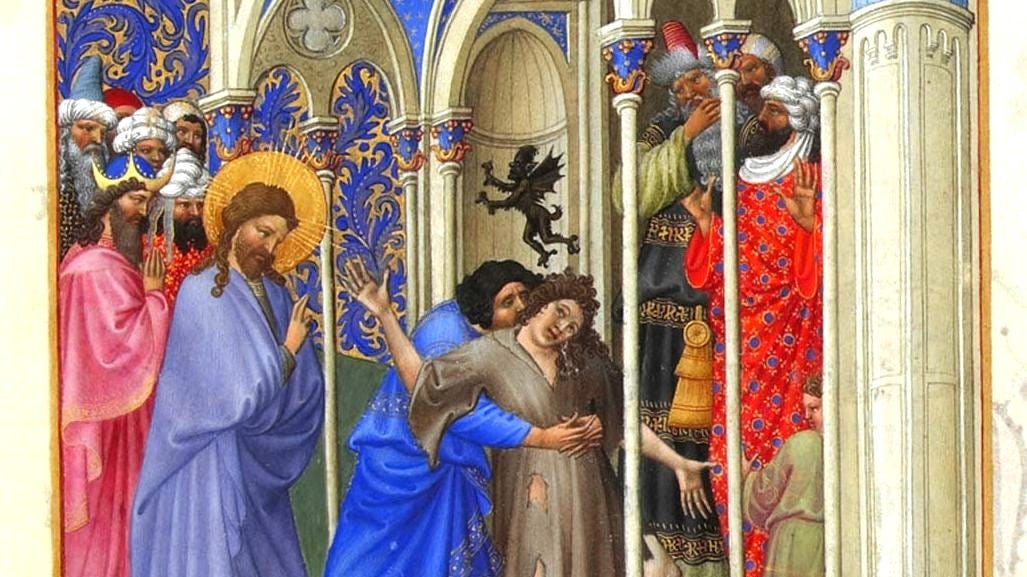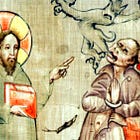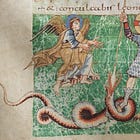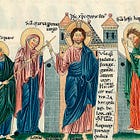How did Christ turn back the charge of casting out devils by Beelzebub?
As Our Lord's fame spread, the malice of his enemies grows.

As Our Lord's fame spread, the malice of his enemies grows.
Editor’s Notes
In this piece, Fr. Coleridge tells us…
How our Lord's miracles provoked slanderous accusations rather than faith.
That his enemies, unable to deny his power, resorted to attributing it to Satan.
Why his response exposed their malice, proving that the Kingdom of God had come.
He shows us that rejection of truth leads to blindness, and calumny is often the refuge of hardened hearts.
Some Context
This episode is sung on the Third Sunday of Lent. Its reading at this time highlights this episode’s connection to the Passion. It occurred in the phase of Christ’s ministry which Coleridge calls “the preaching of the Cross,” which followed St Peter’s confession of faith.
Christ’s presentation as “the stronger man” who overcomes the Devil’s kingdom was surely part of preparing the Apostles for the struggle and apparent failure to come.
In a similar way, those catechumens to be baptised at Lent are being prepared to answer the most important question of every man’s life: “What think you of Christ?”
Our Lord and his Slanderers
The Preaching of the Cross, Part II
Chapter II
St. Luke xi. 14-36
Story of the Gospels, § 103
Burns and Oates, London, 1887
Headings and some line breaks added.
Sung on the Third Sunday of Lent
Part I: How did Christ turn back the charge of casting out devils by Beelzebub?
Part II: The moment Christ announces his invasion of Satan’s kingdom
Part III: Did Christ rebuke the woman who praised his Mother?
Part IV: Why does Christ refuse to prove himself on demand?
Part V: Why does rejecting the truth lead to deeper darkness?
What should we make of ‘repetitions’ in St Luke’s Gospel?
In the passage on which we commented in the last chapter, St. Luke has placed before his readers two heads of our Lord’s teaching which he had omitted in the earlier chapters of his work, in which he had followed the other Evangelists in relating scenes which belonged to the Galilean teaching. Instead of the first form of our Lord’s Prayer, which is found in St. Matthew’s report of the Sermon on the Mount, St. Luke has given the shorter form of which we have just had to speak.
He has added to that shorter form the parable of the man who importunes his neighbour for the loan of some loaves of bread, which is peculiar to himself, and his reason for the report of which seems to be that he thereby introduces as a sequel the words of our Lord which follow about the necessity of instant and urgent perseverance in prayer. These words also had been anticipated in the Sermon on the Mount.
It was inevitable, when our Lord went into parts of the country in which He had not as yet preached, that He should repeat, over and over again, in various places, instructions and exhortations of this kind, and of so high an importance. If St. Luke had been as copious in his account of the Galilean preaching as St. Matthew, he would no doubt have inserted some such instructions in the earlier chapters of his Gospel. But he has reserved many of these heads of doctrine for the time when he was to occupy himself with the ministry of our Lord in Judaea. This enables us to see how much there must always have been in the teaching of our Lord which was identical in various places, while, at the same time, we are able to mark the slight changes or omissions or additions which were probably suggested by the altered circumstances of time or place, or of disposition in those to whom our Lord was at the time addressing Himself.
Identity of our Lord’s teaching and its reception
What is thus true about the substantial identity of our Lord’s teaching at various times and in various parts of the country, is also true with regard to the reception with which He met, whether from those opposed to Him or from those inclined to listen to Him. St. Luke takes care to point out that in this respect the Judaean ministry resembled very closely the former ministry in Galilee.
In the section of the history now before us, the Evangelist speaks of the calumny which was circulated against our Lord, imputing to Him a league with Beelzebub, by virtue of which, as it was insinuated, He cast out devils. The circumstances are very similar to those which are before related by St. Matthew, and partly by St. Mark;1 the calumny is repeated, and, as was also natural, our Lord’s answer and manner of dealing with it are in the main the same. We shall, however, find reason for feeling grateful to St. Luke for the slight touches in which he shows us the differences which are to be found in the midst of so much which is identical.
The dumb demoniac
‘And He was casting out a devil, and the same was dumb. And when He had cast out the devil, the dumb spoke, and the multitude were in admiration at it. But some of them said, He casteth out devils by Beelzebub, the prince of devils. And others, tempting, asked of Him a sign from heaven.’
Of this last-named instance of opposition, which consisted in asking for a sign, we may speak hereafter. St. Luke seems to put it in here, in order to summarise in one short paragraph those two forms of perversity. For the present, it will be enough to speak of the calumny about the prince of the devils.
The first thing to be remarked is the difference between the two cases as related by the Evangelists. In St. Matthew’s narrative, the possessed man was blind as well as dumb, and when he was healed, he both spake and saw. The miracle, therefore, was a double miracle, and it was the cure of two disabilities which do not generally accompany one the other, as in the case of the deaf and dumb man in Decapolis related by St. Mark.2 In St. Luke’s case there was only dumbness besides the possession, and when the devil was cast out, the dumb spoke. Again, in the narrative of St. Matthew, the multitude are unanimous in their admiration.
‘All the multitude were amazed, and said, Is not this the Son of David?’
And after the miracle has taken place, it gets to the ears of the Pharisees, who had been sent down into Galilee by our Lord’s enemies at Jerusalem, and it is with them that the calumnious charge originates.
This Man casteth not out devils but by Beelzebub, the prince of the devils.’
Or, as St. Mark puts it:
‘The scribes who were come down from Jerusalem said, He hath Beelzebub, and by the prince of devils He casteth out devils.’
In the anecdote as given by St. Luke, there is no mention of the Pharisees or Scribes sent from Jerusalem, and yet in all this part of his Gospel, St. Luke constantly mentions them whenever he has an occasion. The persons who made the objection are some of the people themselves.
The people and the Pharisees
This is exactly what we might expect to find in the case before us. Although the Pharisees may not have been present, and although the multitudes before whom this miracle had been wrought were not part of the same population with that which had witnessed our Lord’s sayings and doings in Galilee, still it is natural to suppose that they had very often heard of His name, of His miracles, and of His power over devils. They must have heard of these, and they must, unhappily, also have heard of the hostile attitude of the Chief Priests of Jerusalem towards Him, as well as of the various judgments concerning Him which were in circulation in the Holy City and among the ruling classes.
Thus, some of them were probably already disposed to look upon Him with jealousy and suspicion, to hear Him with a disposition to criticism, and to repeat thoughtlessly the current calumnies by which His marvellous powers were explained. The two narratives put together give us a more perfect picture of the origin and growth and dissemination of the falsehood than we should otherwise possess.
Captiousness of the Pharisees
There is always lurking in the hearts of men in positions of influence and authority, whose lives and hearts are not pure, nor their aims disinterested, a captious disposition to criticise what appears to be the manifestation in others of great and commanding powers, which rival or surpass any that they themselves possess. This captiousness makes them ready to cast about for explanations of such phenomena other than the simple display in them of the working of Heaven.
But in such cases, after the hypotheses of imposture or mistake have been exhausted, there is little room left for any other than the two alternatives of seeing in them either the work of God or the work of the devil. Such men would say to themselves that, as they had reason for denying the first of these alternatives, they might with safety adopt and propagate the other. From the men in authority the word would pass to the people at large, all the more as the facts were undeniable and were constantly repeated. Thus in Judaea our Lord might find the atrocious calumny already in circulation, ready to be produced against Him whenever He gave occasion for it by a work of mercy, such as that here related by St. Luke.
The calumny
The calumny might have been called forth by any instance in which our Lord exerted His Divine power in casting out a devil. But it is natural that the people should be more struck by such a power when the effect was, as in this case, twofold, the restoration of a wanting or impaired faculty, as well as the deliverance from diabolical possession. Indeed, it is clear from the words of our Lord which soon follow, that simple dispossession was not at all unknown to the Jews, and that many of their own priests or Levites were in the habit of exorcising possessed persons with success.
The addition of the miraculous cure of deafness, dumbness, or blindness in any such case could not have been common, and it was therefore this that crowned the admiration of the by-standers, which, as St. Luke tells us, was accompanied by the incredulity of some, who went on to utter the calumny about Beelzebub. They were so far more excusable than the Scribes and Pharisees, who had been the original inventors of the story, that they only adopted and repeated what they heard. Our Lord, in His dealing with their case, does not use quite the same severity as on the former occasion, on which, as St. Matthew tells us, He ‘called them together,’ as if His purpose was to make His warning to them more solemn.
Answer of our Lord
‘But He, seeing their thoughts, said to them, Every kingdom divided against itself shall be brought to desolation, and house upon house shall fall.’
In Galilee, as St. Mark tells us, He began by putting the truth which He was proposing in the form of a question, ‘How can Satan cast out Satan?’ Here He simply answers their thoughts. He puts the matter to them on grounds of reason and experience. It was a truth which all could understand, that a kingdom divided against itself must be brought to desolation, and a house divided against itself—for that is the meaning of the passage about ‘house upon house’—must fall.
Not all kingdoms or houses that are united and solidly knit together are so far certain to escape ruin from without. But houses or kingdoms which have the canker of internal discord are certainly on the way to ruin.
‘And if Satan be divided against himself, how shall his kingdom stand? because you say that through Beelzebub I cast out devils.’
The last words may be added on the present occasion, to explain why He had asked the question, without having the calumny openly avowed by them.
Argument from reason
Our Lord goes on, as before, to add another simple argument from reason. As has been said, the practice of exorcism was familiar enough to the Jews. It could be safely made the ground of a complaint, which showed that nothing but malice could justify their accusation against Him. For the same thing which in Him, as they said, implied that He was leagued with Satan, was done continually by other persons whom they respected for their office and the zeal with which it was exercised.
‘Now, if I cast out devils by Beelzebub, by whom do your children cast them out? Therefore they shall be your judges.’
The office of exorcist may have been frequently committed to young persons, and we find that in the early Christian ages children as well as others used this power. The enemies of our Lord were therefore convicted of inconsistency and malice by the facts of the case, for they made no charge of a league with Satan against their own exorcists.
The conclusion from the facts
Our Lord continues in words nearly the same with those which He had used before. The fact of the exercise of the power in question could not be ignored, nor could it be legitimately explained by the false theory of a league with Satan. There was no ground for this theory, in the first place, and, in the second place, it implied that Satan was undoing his own work and destroying his own kingdom.
What, then, was the only legitimate conclusion that was to be drawn from what was so notorious and so conspicuous? It was that the dispossessions in question were wrought by the power of God, by the instrumentality of the Holy Ghost, who is called the ‘finger of God,’ the Spirit of Holiness driving out by His own inherent power the spirits of evil who were usurping that dominion over man which belonged to God alone. This being so, another thing followed. These miracles were wrought by Divine power, and they were wrought, not simply as works of mercy, but as evidences and testimonies of the mission of Him by whom they were wrought. They were proofs that God was with Him, and that what He proclaimed about the advent of the Kingdom of Heaven was to be received as authenticated by God.
‘But if I by the finger of God cast out devils, doubtless the Kingdom of God is come upon you.’
Satan is not fighting against himself. Satan is cast out by a superior and a hostile power. His kingdom is being brought to desolation, not by internal discord, but by external force.
Our Lord goes on, in words again repeated from the former occasion, to describe the invasion of the kingdom which Satan had set up in the world by the new Kingdom of which He was Himself the founder.
End of Part I. Having refuted the calumny, our Lord explains the meaning broached here even further: his works proclaim the fall of Satan’s kingdom. He next speaks of the house of “the strong man,” showing that he is “the stronger man” and that his mission is not mere exorcism but the overthrow of the enemy’s dominion:
Our Lord and his Slanderers
Part I: How did Christ turn back the charge of casting out devils by Beelzebub?
Part II: The moment Christ announces his invasion of Satan’s kingdom
Part III: Did Christ rebuke the woman who praised his Mother?
Part IV: Why does Christ refuse to prove himself on demand?
Part V: Why does rejecting the truth lead to deeper darkness?
Read Next:
Here’s why you should subscribe to The Father Coleridge Reader and share with others:
Fr Coleridge provides solid explanations of the entirety of the Gospel
His work is full of doctrine and piety, and is highly credible
He gives a clear trajectory of the life of Christ, its drama and all its stages—increasing our appreciation and admiration for the God-Man.
If more Catholics knew about works like Coleridge’s, then other works based on sentimentality and dubious private revelations would be much less attractive.
But sourcing and curating the texts, cleaning up scans, and editing them for online reading is a labour of love, and takes a lot of time.
Will you lend us a hand and hit subscribe?
Follow our projects on Twitter, YouTube and Telegram:
Story of the Gospels, § 56.
Story of the Gospels, § 77.







That the image at the top depicts an exorcism should probably be explained in the caption as other explanations are possible.